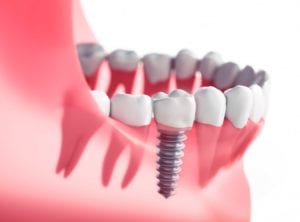One of the main benefits of dental implants is their ability to restore natural chewing function in people who previously had missing teeth. This is because when implants are placed into the jawbone, they will fuse with the surrounding bone as they heal. In about 95-96% of cases, dental implants are able to fuse successfully with the bone, allowing them to act as an anchor point for a dental prosthetic.

A small percentage of dental implants, however, are unable to properly fuse with the surrounding jawbone. When this happens, the affected implant is said to have failed and must be removed. While implant failure is rare, there are certain factors that can increase the risk. These factors include: inadequate bone mass, poor oral hygiene habits, previous gum disease, not adhering to a soft foods diet, and smoking. Recently, researchers have also identified one other possible risk factor: a change in the dominant chewing side.
Researchers at the RUDN University note that, “Most people don’t chew symmetrically on both sides of the jaw but have a dominant side that accounts for up to 75% of chewing movements”. Basically, the dominant chewing side is the side that you feel most comfortable chewing with. Chewing more on one side of the mouth than another can lead to increased wear on the teeth of the dominant chewing side. Additionally, the jaw joint on the opposite side must work harder to provide the necessary force for chewing.
Researchers believe that increased force on both the teeth and jaw joint could affect a dental implant’s ability to properly osseointegrate. To test this theory, they set up a study monitoring 64 patients from the ages of 22-67 who had dental implants placed on one side of the mouth. Prerequisites for this study required that implant patients were free of periodontal disease, had minor defects in the lower jaw, and maintained satisfactory oral hygiene.

At the start of the study before the implants were placed, a series of tests were performed. For starters, dental x-rays of the teeth and CT images of the jaw were taken. Patients also had the strength of their chewing muscles tested. Once these tests were completed, the patients received their dental implants.
After having their dental implants placed, patients were then evaluated twice: once at the 3-6 month mark and once at the 9-12 month mark. During these postoperative evaluations, dental x-rays and CT images were taken, and their chewing strength was measured. Additionally, patients were asked to fill out a questionnaire focusing on their chewing habits. The results of this questionnaire found that 62% (40 out of 64) had a change in their dominant chewing side, while 38% (24 out of 64) maintained the same dominant chewing side.
Once researchers had the breakdown of which patients changed their dominant chewing side and which did not, they labeled these groups. Subgroup A was defined as people who changed their dominant side, while subgroup B was defined as those who did not change. When these two groups were evaluated postoperatively, it was found that 90% of subgroup A maintained proper bone mass for osseointegration, as compared to 95% of subgroup B. Furthermore, subgroup A was more likely to have deterioration of the jawbone at the 3-6 mark, while only one individual from subgroup B had deterioration, but at the 9-12 month mark. Finally, it was concluded that those who maintained their dominant chewing side were more likely to have implant success.



